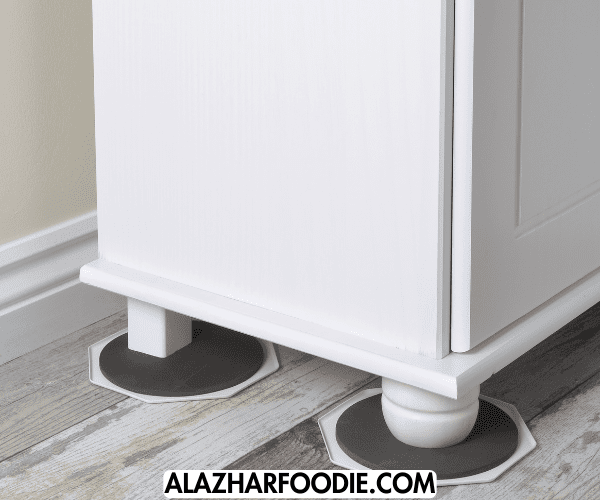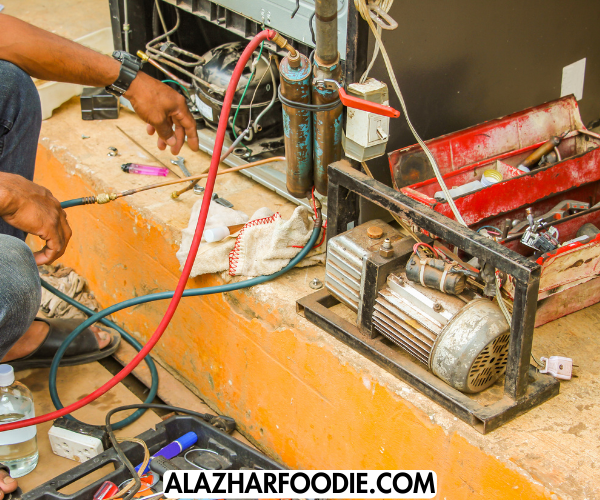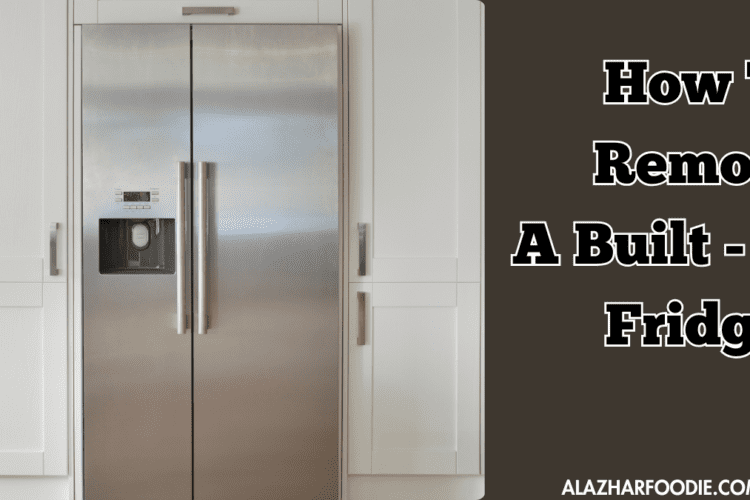How To Remove A Built In Fridge?
Topic: How To Remove A Built In Fridge?
Table of Contents
Introduction:
Taking out a built-in fridge may seem overwhelming, but it can be easily accomplished with proper instructions. If you plan to upgrade your appliance or renovate your kitchen, it’s important to understand the proper steps for removing a built-in fridge.
This will help you avoid any potential damage and ensure a seamless transition. Our comprehensive guide will provide you with a step-by-step process with clear instructions and valuable tips to simplify the task.
Integrated fridges are designed to seamlessly blend with your cabinetry, which makes removing them more involved than freestanding models. Proper preparation is crucial, including emptying the fridge and disconnecting power and water lines.

During the removal process, it is essential to prioritize safety. We will provide you with valuable information on best practices to protect yourself and the appliance.
Our comprehensive guide provides step-by-step instructions on detaching the fridge from its enclosure, ensuring a safe and efficient moving process. We will provide solutions to common challenges and offer troubleshooting tips to assist you in overcoming any obstacles you may encounter.
By following our expert advice and utilizing the suggested tools and techniques, you’ll have the knowledge and resources to successfully remove a built-in fridge confidently and easily. Now, let’s begin!
Detailed Guide: How To Remove A Built In Fridge?
Getting the Area Ready:
- It is important to ensure that the area around the built-in fridge is clear and easily accessible. Clear out any items currently stored in the fridge and the cabinets nearby.
- Ensure a clear pathway facilitates smooth maneuvering during the removal process.
How to Disconnect Utilities?:
- Prior to moving forward, it is crucial to disconnect any utilities that are currently connected to the fridge. As part of the process, it is important to disconnect the power cord from the outlet and, if necessary, shut off the water or gas supply.
- It is important to follow the manufacturer’s instructions or seek guidance from a professional if you need clarification.
Important Safety Measures:
- It is important to prioritize safety before proceeding with the removal process.
- To avoid injuries, wearing protective gloves when working with sharp edges or heavy components is important.
- Furthermore, it is important to ensure that the area has adequate lighting and is clear of any obstacles to ensure safe and easy movement.
Remove the Outer Casing:
- Depending on its design, removing any decorative panels or trim that hide the fridge may be necessary.
- Following the manufacturer’s instructions is important to safely detach the outer casing.

Evaluate the Mounting Mechanism:
- Mounting screws, bolts, or brackets are commonly used to secure built-in fridges to the surrounding cabinetry or enclosure.
- Examine the edges of the fridge to find these fasteners.
- Concealment is often achieved by placing them behind decorative panels or trim pieces.
Collect the essential tools:
- Gather the necessary tools for removing the mounting fasteners. Depending on the type of fasteners being used, you might need different tools like a screwdriver, wrench, or drill.
- In addition, it’s a good idea to have a strong dolly or appliance cart available to help transport the fridge.

Remove and loosen the mounting fasteners:
- To detach the fridge from the cabinetry, use the correct tool to loosen and remove the mounting fasteners.
- Begin by focusing on the screws or bolts positioned at the top of the fridge, then proceed to those on the sides and bottom.
- It is important to keep track of the fasteners as you remove them, as they will be necessary for reinstallation.
Enlist Help:
- Removing built-in fridges from tight spaces can be challenging due to their weight and awkwardness.
- It would be beneficial to have someone you trust, like a friend or family member, to lend a hand in lifting and supporting the weight of the fridge while you remove it.
- Ensure a smooth and controlled extraction by coordinating your movements.
Pull out the fridge:
- After removing the mounting fasteners and ensuring you have someone to help, gently slide the fridge away from the enclosure.
- Tilt the fridge slightly backward to disengage from the mounting brackets or tracks.
- It is important to exercise caution in order to prevent any scratches or damage to the surrounding surfaces.
- When it comes to integrated fridges, it’s important to keep in mind that they can be quite heavy.
- To ensure a smooth and safe installation process, it’s recommended to seek assistance from someone physically fit and capable of handling the weight.
- When lifting a fridge, being cautious and mindful of your body’s position is important. Use your legs and maintain proper posture to prevent any potential strain.
- It is important always to keep the fridge upright to protect the motor and internal components. It is advisable to refrain from tilting or laying it on its side.
Remove any objects that are blocking the way:
- When moving the fridge, it’s important to be aware of any obstacles or obstructions that may be in the way.
- Ensure to clear away any furniture, appliances, or debris that could get in the way during removal. It is important to maintain a steady and controlled pace in order to prevent accidents or damage.
Examine and tidy up:
- After removing the fridge, it’s important to carefully examine the surrounding area for any signs of damage or debris.
- Inspect the floor, walls, and cabinetry for any signs of damage that may have occurred during the removal process.
- Ensure the area is cleaned thoroughly before installing a new appliance or for other purposes.
Ensure the Utilities are Safely Disconnected:
- When you’re not installing a new fridge immediately, taking precautions to secure the disconnected utilities is important.
- To prevent leaks, make sure to cap off the water supply line. Additionally, it’s important to tape the gas shut-off valve closed to avoid any accidental activation.
- Keeping the power cord stored securely is important to prevent accidents or damage.
By carefully following the step-by-step instructions, you can safely and efficiently remove a built-in fridge once you have disconnected the necessary utilities. Focusing on safety, seeking help, and approaching the removal process systematically is important to achieve a successful outcome without any harm or damage.
Safety Tips:
It is crucial to prioritize safety when removing a built-in fridge. Here are some safety tips to help you have a smooth and accident-free removal process:
Proper Lifting Techniques:
- When lifting the fridge, it’s important to use proper lifting techniques to prevent any strain on your back or potential injuries.
- It’s important to maintain good form when lifting by bending your knees and keeping your back straight.
- It would be helpful to have someone you trust, like a friend or family member, to lend a hand with lifting and supporting the weight of the fridge.
Importance of Protective Gear:
- Wear protective gear, such as gloves, closed-toe shoes, and safety goggles, is important. Gloves are essential for maintaining a secure grip and safeguarding against potential harm from sharp edges.
- Similarly, closed-toe shoes are crucial in providing support and minimizing the risk of foot injuries.
- Wearing safety goggles is essential for safeguarding your eyes from any potential harm that may arise during removal. They effectively shield your eyes from dust, debris, and other hazards.

Strong Shoes:
- It’s important to wear footwear that provides good traction to avoid slipping and falling when moving the fridge.
- It is important to refrain from wearing loose clothing that could become entangled in any protruding parts or moving components of the appliance.
Ensure the Area is properly secured:
- It is important to ensure that the area is free from any obstacles, tripping hazards, or fragile items that may be at risk of damage during removal.
- Ensure a clear path for maneuvering the fridge and enough space to work safely.
Ensure Safety When Using Tools:
- It is important to handle tools and equipment with care, following the instructions provided by the manufacturer and adhering to safety guidelines.
- It is important to use the right tools for the job and avoid applying too much force, as this can result in accidents or harm to the appliance.
Being Mindful while Maneuvering:
- It is important to pay attention to your surroundings and consider the weight distribution of the fridge when moving it.
- It is important to be cautious and avoid sudden movements or jerks that may destabilize the appliance or lead to it tipping over.
- It is important to exercise caution and be mindful of your surroundings, particularly when maneuvering around corners or in confined areas.
Safeguard your Surfaces:
- To ensure the safety of your appliance and the surfaces around it, it is recommended to utilize furniture sliders or appliance glides.
- These tools will help facilitate seamless movement without causing any damage.
- It is recommended to place protective padding or blankets underneath the refrigerator to provide cushioning and avoid any potential damage to the floor or walls.
Ensure the Appliance is Stable:
- To ensure the fridge remains stable, it is important to prop it against a wall or secure it with straps or ropes after removing it from its enclosure.
- This will prevent any tipping or shifting. It is important to be mindful of the weight distribution and avoid putting too much pressure on fragile components or doors susceptible to damage.
By implementing these safety measures, you can greatly reduce the chances of accidents, injuries, and damage while removing a built-in fridge. Ensuring a successful and incident-free removal experience requires prioritizing safety at every process step.
Tools and Materials:
To safely remove a built-in refrigerator, it is important to have the following tools and materials:
Tools:
- Set of Screwdrivers: Remove any screws or fasteners that are securing the fridge in place.
- An adjustable wrench:It is a versatile tool that can be used for various tasks. Handy for disconnecting water lines or other fittings.
- Utility Knife: Remove any sealant or adhesive around the fridge.
- Pliers: Designed for effective gripping and pulling.
Safety Equipment:
Durable Gloves: Ensure the safety of your hands when dealing with sharp edges and heavy objects.
Importance of Safety Glasses: Protect your eyes from particles or dirt.
Closed-toe footwear: Stay safe and protect your feet from injuries.

Equipment for Moving:
Appliance Dolly: Crucial for the task of lifting and moving the heavy fridge.
Furniture Sliders: These can be placed under the fridge to ensure smooth movement without causing any damage to the floor.
Shifting Pads or Blankets: It is important to wrap the fridge properly to ensure its safety during transportation.

Materials:
Use rubber bands or tape: Make sure to properly secure the plug and doors before removing them.
Plywood or Cardboard: Placing something under the fridge can help protect the floor.
Sealant or caulk: If necessary, for sealing again after being removed.
It is important to remember the necessary safety precautions and consider working with a partner to ensure a smoother and safer process. Wishing you the best as you tackle removing your built-in fridge! 🛠️👷♂️
Troubleshooting:
During the built-in refrigerator removal process, it’s important to be aware of potential issues or challenges that may arise. Here are some tips on how to address them:
Difficulty with Limited Space:
Problem:
Occasionally, integrated fridges are tightly installed in their cabinets. It can be quite difficult to remove them.
Solution:
- Ensure to inspect the fasteners:
- Be sure to thoroughly inspect the fridge for any concealed screws, bolts, or brackets that may be holding it in place. Handle them with caution.
- Wiggle and Lift:
- Ensure a secure grip on the fridge and apply a gentle wiggling motion while lifting it. Using this technique can assist in gently dislodging it from its current placement.
Water Line Disconnection:
Problem:
Integrated fridges commonly have water lines to accommodate ice makers or water dispensers.
Solution:
- Turn off the water supply:
- Please ensure that you switch off the water supply to the refrigerator.
- How to Disconnect a Water Line?:
- To disconnect the water line, you can use an adjustable wrench. Expect some water to be spilled.
Sealant or Residue from Adhesion:
Problem:
The fridge can be caulked or glued.
Solution:
- Sealant Cutter:
- Utilize a utility knife to carefully cut through any sealant or adhesive that may be present around the edges.
- Delicately Separate:
- Take caution when moving the fridge away from the wall to avoid any potential damage to the surrounding area.
Uneven Floors:
Problem:
Uneven floors can pose a challenge when it comes to moving the fridge.
Solution:
- Consider utilizing furniture sliders:
- To move your fridge easily, try placing furniture sliders under its feet. Smooth movement is possible, even on surfaces that are not level.
Removing a Door:
Problem:
Certain doorways or hallways might need to be narrower to accommodate the refrigerator.
Solution:
- Eliminate Doors:
- If it’s feasible, consider removing the fridge doors. Refer to the manufacturer’s instructions for guidance.
Weight Distribution:
Problem:
It is important to be aware that built-in fridges can be quite heavy, and it is crucial to lift them properly to avoid straining your back.
Solution:
- Remember to always lift heavy objects using your legs instead of your back.
- It’s important to remember to bend your knees and use your leg muscles rather than your back when lifting.
- Utilize an Appliance Dolly:
- Consider purchasing an appliance dolly to ensure the safe transportation of your refrigerator.
Logistics of Disposal:
Problem:
Discovering the proper method for disposing of the old fridge.
Solution:
- Regulations in your area:
- Explore available local disposal options. Certain regions have established recycling programs or provided detailed instructions for properly disposing of appliances.
It is important to approach your work systematically, keeping safety as your top priority. If you encounter any uncertainties, it is always wise to consult with a professional for guidance. Have a pleasant removal! 🛠️👷♂️
Disposal or Recycling:
Once you have successfully removed your built-in fridge, it is important to consider the various options available for its disposal or recycling:
Recycling:
- Local Recycling Centers:
- Make sure to inquire with your nearby recycling centers about their policies regarding disposing of large refrigerators.
- Certain centers may have particular guidelines regarding appliance recycling.

- Manufacturer Initiatives:
- Certain fridge manufacturers provide recycling services. You can contact the manufacturer or check out their website to find out about recycling options.
Contribution:
- Working Condition:
- If your fridge is still in good working condition, consider donating it to a local charity, community center, or a needy family. It is important to clean it thoroughly before donation.
- Appliance Reuse Initiatives:
- Seek organizations with expertise in refurbishing and distributing appliances to households with limited financial resources.
Proper disposal:
- Reliable Removal Services:
- Consider hiring a professional service to handle your appliance removal needs.
- The fridge will be transported and disposed of by local regulations to ensure safety.
- Landfill:
- If recycling or donation is not possible, it is recommended to contact your local waste management facility for assistance with proper disposal at a landfill.
Eco-friendly Practices:
- Removing Refrigerant:
- When disposing of the fridge, it is important to have a certified technician properly remove the refrigerant, typically Freon. Releasing refrigerants can harm the environment.

- Understanding Metal Recycling:
- Fridges are made up of valuable metals such as steel and copper. Consider taking it to a scrap metal recycling facility.
It is important to adhere to the regulations and guidelines set by your local authorities regarding the proper disposal of waste. Choosing an eco-friendly option helps to create a cleaner environment. 🌿🌎
Post-Removal Steps:
Once you have successfully removed your built-in fridge, it is important to follow these post-removal steps to maintain a clean and well-prepared space:
Tidy up the space:
- Fine particles and small fragments:
- Clean the floor surrounding the vacant area by vacuuming or sweeping. Clean away any dust, dirt, or debris.
- Clean Surfaces:
- Wipe down nearby walls, cabinets, or countertops with a damp cloth. It’s important to be mindful of any sticky residue the fridge may leave.
Check for any Signs of Damage:
- Types of Flooring:
- Inspect the floor for any signs of damage that may have occurred during the removal process. Repair or cover any damaged areas if necessary.
- Wall Paint:
- Examine the wall paint or wallpaper. Repair any holes or scrapes. Sealing or filling gaps is important for maintaining the integrity of a structure.
- Choosing the Right Caulk or Sealant:
- To ensure proper sealing, it is recommended to reapply caulk or sealant around the edges of the fridge if there are any gaps or exposed areas.
- By maintaining a tidy look, you can avoid any unwanted air currents.
- Trim or molding:
- Replacing any trim or molding around the fridge space is important.

Protecting Your Floors:
- Furniture Sliders:
- Having furniture sliders on hand is a good idea to protect your floors from damage when moving heavy appliances or furniture.
- Types of Floor Coverings:
- Consider placing a rug or mat beneath the new appliance to safeguard the floor.
Assess Plumbing and Electrical:
- Unused Outlets:
- Covering any electrical outlets behind the fridge with outlet covers is advisable.
- Water Lines:
- Make sure to seal or cap any water lines that have been disconnected.
Revitalize the Area:
- Allow for proper ventilation:
- Consider opening windows or utilizing fans to circulate air and improve the overall freshness of the space.
- Occasionally, older appliances may emit persistent odors. Consider adding plants or decorative items to enhance the space.

Proper Disposal of an Old Fridge:
- Adhere to the guidelines set by your local authorities:
- Ensure that you make arrangements to dispose of or recycle your old fridge, if needed, properly. Refraining from leaving it in a public area or on the curb is advisable.
It is important to take some post-removal steps to maintain the functionality and appearance of your kitchen. Make the most of the extra space you now have!🌟🧹🔧
Conclusion:
To successfully remove a built-in refrigerator, it is important to approach the task with careful planning, prioritize safety precautions, and pay close attention to detail. Here’s a summary:
Prioritizing Safety:
- It is important to prioritize safety at every step of the process.
- It is important to have someone assist you, wear appropriate protective gear, and carefully adhere to the provided guidelines.
Required Tools and Materials:
- Essential tools for any toolbox include a screwdriver, wrench, utility knife, and pliers.
- It is important to wear safety gear such as gloves, safety glasses, and closed-toe shoes.
- Essential equipment for moving includes an appliance dolly, furniture sliders, and blankets.
- Essential materials for this project include tape, cardboard, and sealant.
Some common challenges include:
- Ensure that you thoroughly inspect for any concealed fasteners causing the obstruction.
- Water line: Turn off the water supply and disconnect it.
- Removing sealant residue requires a careful and gentle approach. Use a cutting tool and pry gently to avoid causing any damage.
- Uneven flooring can be easily addressed by using sliders.
- For door removal, it is important to follow the instructions provided by the manufacturer carefully.
Available methods for disposing of items:
- Options for recycling include local centers or manufacturer programs.
- Donations are accepted if the item is in good condition.
- Proper disposal: Landfill should be considered as a last option.
Removing Refrigerant:
- It is recommended to hire a technician who is certified.
- Ensuring safety and proper ventilation is crucial.
- Use a recovery unit to extract the desired substance.
- Properly handle the disposal of waste.
Steps to Take After Removal:
- Ensure the area is clean, carefully examine for any signs of damage, and then seal any gaps found.
- Assess the electrical and plumbing systems.
Following these steps, you can easily remove your built-in fridge and transform your kitchen space.
People Also Ask:
Can you remove built in fridge?
To properly install an integrated fridge, removing the casing surrounding it is necessary. Pulling the door, plinth, panels, and trim may be required for certain models. Rest assured, it is unlikely that you will have to remove any of the work surfaces.
What are the disadvantages of built-in refrigerators?
One thing to consider about built-in refrigerators is that they are generally more expensive than freestanding fridges. Additionally, they are designed to be relatively moved. Proper installation is crucial, and it’s important to attach them to the wall securely.
What is the life expectancy of a built-in refrigerator?
According to the U.S. Department of Energy, refrigerators typically last around 12 years. The number of variations in the cost of the appliance depends on the type you purchase and how well you maintain it.
It’s important to note that the lifespan of a refrigerator can vary significantly depending on its quality and maintenance.
While a poorly made fridge may malfunction within a few months, a properly maintained appliance can last up to two decades.
Are built in fridge worth it?
Standard refrigerators typically have a lifespan of 8-10 years, while built-in models are designed to a higher standard and tend to last significantly longer. While the initial cost of built-in refrigerators may be higher than standard models, they tend to have a considerably longer lifespan of two to three times.
Cost to remove built-in refrigerator?
Their Built-In Refrigerator Removal Service is available from $85 to $100. For more details, you can refer to these websites.
Built in refrigerator removal service?
If you need professional services to remove your built-in refrigerator and other appliances, here are some options:
- 1-800-GOT-JUNK?: They provide removal services for various appliances, such as refrigerators, stoves, washing machines, etc.
- Junk King: Junk King offers efficient and safe disposal services for appliances such as refrigerators, ovens, and dryers. Our methods are also eco-friendly, ensuring that they prioritize the environment’s well-being.
- RecycleZone: At RecycleZone, they provide convenient same-day removal services for white goods, such as refrigerators, microwaves, and dishwashers.
- Don’s Appliances: At Don’s Appliances, they are experts in providing top-notch appliance services.
- Their services include delivery, installation, and repair, ensuring that all your appliance needs are met with utmost professionalism and efficiency.
- In addition to their other services, they also provide built-in refrigerator removal.
- LoadUp: Easily schedule your appliance removal, disposal, and recycling services with LoadUp’s convenient online booking system.
Take your time to explore these options and select the one that aligns with your requirements. Best of luck with your appliance removal!
Remove fridge door panel?
Taking off the door panel of a refrigerator is usually a simple and easy task. Here’s a step-by-step guide on how to remove the door panel:
Preparation:
- Before starting, it is important to ensure the refrigerator is disconnected from the power outlet to avoid any potential electrical mishaps.
- It is recommended to remove all items from the refrigerator door shelves and drawers before moving them. This will help reduce the weight and prevent any potential accidents or items from falling out.
How to Access the Screws?:
- Refrigerator door panels are typically held in place by screws positioned along the edges of the door.
- Plastic covers or trim pieces are commonly used to hide these screws.
- Thoroughly examine the edges of the door to find these covers or trim pieces.
Removing the Covers or Trim Pieces:
- To remove the plastic covers or trim pieces that are concealing the screws, carefully utilize a flathead screwdriver or a pry tool.
- Place the screwdriver or pry tool into the seam between the cover and the door, then gently separate it from the door surface.
- It is important to exercise caution when applying force to prevent any potential damage to the covers or door surface.
Removing the Door Panel:
- After the screws are visible, use a suitable screwdriver to loosen and take them out gently.
- It is important to keep track of the screws as you remove them, as they will be needed for reinstallation later on.
- There could be several screws holding the door panel in place, depending on the refrigerator model.
How to Remove the Door Panel?:
- After removing the screws, carefully lift the door panel off the refrigerator door. The panel is typically secured using retaining clips or hooks along the edges.
- To remove the panel, lift it upward and away from the door, making sure to disengage any clips or hooks.
Reinstalling:
- To reinstall the door panel for maintenance or replacement, follow the steps in reverse order.
- Make sure to tighten all screws securely and reattach any plastic covers or trim pieces.
Tips for Cleaning and Maintenance:
- While the door panel is removed, it’s a good idea to clean both the panel and the exposed areas of the refrigerator door.
- For cleaning, it is recommended to use a gentle detergent solution along with a soft cloth to remove dirt or stains effectively.
- In addition, it is important to thoroughly examine the door gasket for any indications of wear or damage. If any issues are detected, it is recommended that they be promptly replaced.
By carefully following these steps, you can safely remove the door panel of your refrigerator for maintenance, cleaning, or replacement purposes. If you encounter any problems or have any concerns about the process, check the refrigerator’s user manual or seek help from a professional technician.
How to remove Undercounter refrigerator?
Removing an under-counter refrigerator is typically easier than removing a built-in or full-size refrigerator. Follow the steps provided above to safely and effectively remove an under-counter refrigerator.
How do you get behind a built in refrigerator?
The appliance is typically attached to the surround using small L-shaped brackets. To access the back, you must locate these components and unscrew them. When the fridge/freezer is filled, it can become quite heavy.
How to move a built-in fridge?
When relocating a built-in fridge, it is important to disconnect the necessary utilities such as power, water, and gas lines. Take out any shelves or drawers from the interior.
To detach the fridge from the enclosure, loosen the mounting screws or bolts. When moving the fridge, it’s important to be cautious and avoid causing any damage to the floors or walls.
Seek assistance and carefully slide the fridge away from the wall. It is important to exercise caution when dealing with built-in fridges, as they can be heavy and require careful maneuvering.
Recommended Articles:
Nursing School Graduation Cake
Why Is The Dishwasher Not Draining
How Long Does A Sub Zero Fridge Last?
How Long Can A Jackery 1000 Run A 12V Fridge?



